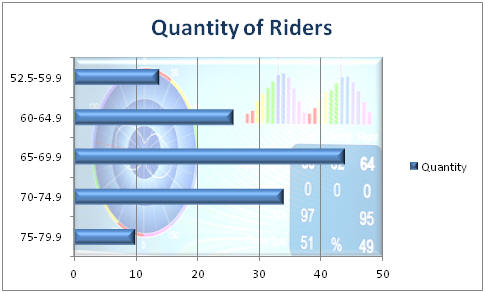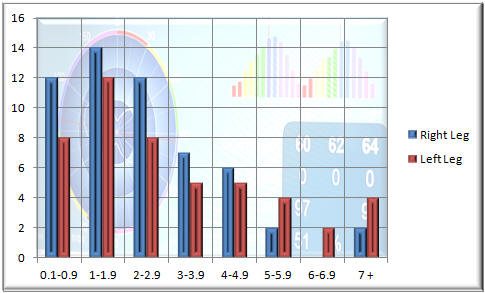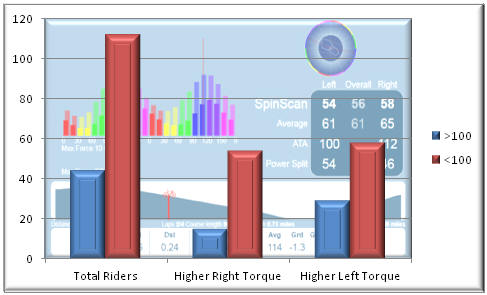
Pedal stroke analysis performed to 130 riders.
During the year that is ending, I had the opportunity to analyze the pedal stroke of 130 riders that participated in our 5K program 190 times; additionally twelve cyclists were studied under special climbing program. Based on the history of the sample, we have divided the riders into 5 groups according to the data provided by the system in relation to the round pedaling. It is clear that this is made up of three main sections, the first is at the point where the greatest amount of force occurs, in most cases the horizontal position, which we call torque; the second is the first force that we do with the leg is going down, the third and final, by ending a full circle, with the strength of pulling up. The groups range in increments of 5 units, starting the first section from 52.5 to 59.9 and the highest is from 75 to 80. The first section indicates an incomplete force to complete a round pedaling where the force required to pull is not used to the maximum, the sample gives us 10.94% of those studied. On the second level we have 20.31% of the population, then the next group had the highest percentage, 34.38% or 44 riders, they are located in the middle section where the pedal stroke is between 65 and 69.9. In this particular group the expectations of improving pedaling still very high, of course with a good program of weekly exercises. The following range, deliver us a 26.56% of the participants (34), and then we find that only 10 riders are between 75 and 78.5. It is totally impossible to reach one hundred percent, as it would be required to impose the same force through 360 degrees of each clutching. As you can see those who are over 75 have higher efficiency and performance on the road. Therefore the importance that each of you always looks for ways of improving your pedaling, a higher effectively will take us farther or sooner to a certain point.


We had the opportunity to display the differences in performance and strength imposed on each of the legs for every 360 degrees of rotation. It caught our attention that from 106 riders analyzed 3 only had an even distribution of forces in each leg, which gave exactly the same (50% - 50%). The predominance of the remaining riders is dominated by right-handed at a ratio of 55 to 48. This analysis is divided into 8 sections, starting from 0.1 - 0.9 up to deviations above 7 points. The largest number of racers is in the second section where right-handed, predominantly 14 and 12 have a left domain; this represents 25.25% of those tested, with a deviation in strength between each leg of 1 to 1.9. The second largest group is in the third section, where the differences between each leg are from 2 to 2.9 points with a total of 20 riders; where right-handed surpass by 4 to the lefties. Other data similar to this was in the first group, where the variations are from 0.1 and 0.9. In conclusion we came to think that some of us have a "laziest" leg than others, here too with good conscience and a little of exercising, can achieve matching any differences and balance the forces between each leg so we can get a little bit more efficiency. 31 riders sat on more than one occasion, eighty in a total combined, in search of the necessary parameters to improve, only one rider remained at the same level, 73 although the two tests presented a different cadences (96.1 and 100.8) the rest showed improvement between one to five points in the grand total of the pedal stroke, gaining by being more efficient. At the end of the day this remains a competition where times can translate into efficiency gained in this study, where one rider improved his best time in three minutes, six more shortened distances over a minute, the same amount did the equally between 30 and 59 seconds, the remaining field (18) improved bellow 29 seconds. It gets demonstrated that everyone has still much room for growth in terms of how we pedal.
The average torque angle (torque) is the place where our crank has the highest use of force in each of the legs. Surprisingly we find that there is no direct correlation between the distribution of power between each leg and the torque imposed by each one. 55 right-handed predominantly riders only 19 (34.54%) produced a greater torque with the same leg; while out of 48 lefty cyclist, 20 only (41.67%) have the maximum torque at same side. Each clutching is not the same as the one before and also varies from day to day. The average torque angle divided by its maximum and multiplied by 100 gives us the value of our rounded pedal stroke, reason for our study. We took the average torque of 156 racers, and 44 of them are above 100 while only 15 (34.09%) have a right side predominance, those under 100, or 112 riders, only 54 (48.21%) have also tilt inclination to be right-handed. We can conclude that the pedal stroke is a combination of forces generated by both legs in different parts of the circle that completes each rotation, where sometimes a bad position on the bike or just an uneven click can make a difference in obtaining the highest efficiency available in pedaling. Not all of us pedal equally, therefore the importance of learning how we do it; so we can establishing the parameters and tasks necessary for improvement, no matter in which of the 5 levels we are, there is always room for progress. An important point here to denote is what we saw in the climbing samples obtained from a small field, they showed a decrease in the values of the rotation in pedaling, and this is due to the change of position on the bicycle when exercising a climb. The primary guide for analysis presented here, it was basically developed in a windless flat road.
